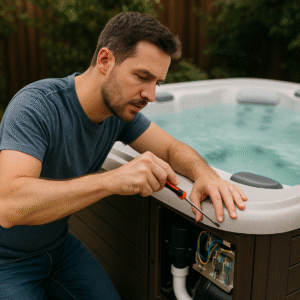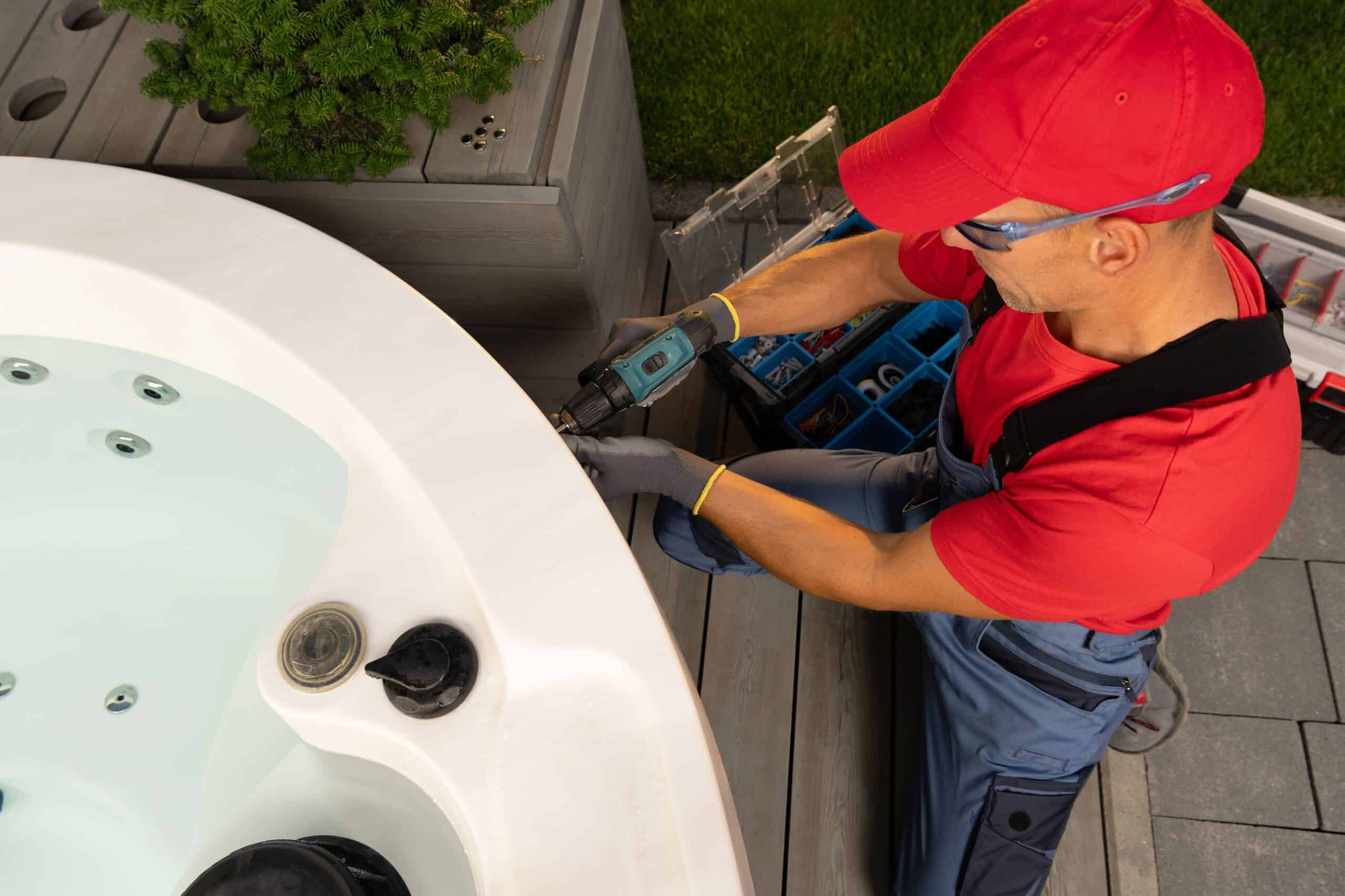Table of Contents - How to Repair Your Hot Tub: A Comprehensive DIY Guide
This blog post may contain affiliate links. As an Amazon Associate I earn from qualifying purchases.
How to Repair Your Hot Tub: A Comprehensive DIY Guide

Have you ever found yourself in hot water with your hot tub? We’ve all been there! That moment when you’re ready to relax, only to find your beloved spa isn’t working quite right. But don’t worry, we’re here to help you dive into the world of hot tub repair. Whether you’re dealing with a leaky tub or a faulty heater, or you just want to learn how to maintain your spa, our comprehensive DIY guide has got you covered.
In this article, we’ll walk you through the most common hot tub issues and their telltale signs. We’ll also give you the lowdown on the essential tools and materials you’ll need to have on hand for your repairs. Then, we’ll guide you step-by-step through diagnosing problems and fixing them yourself. To top it off, we’ll share some handy tips to keep your hot tub in tip-top shape. So, grab your tools, and let’s get started on making your hot tub troubles bubble away!
Common Hot Tub Issues and Symptoms
Let me tell you, as a hot tub enthusiast, I’ve had my fair share of spa troubles over the years. But don’t worry, we’re going to dive into the most common issues you might face and how to spot them. Trust me, once you know what to look for, you’ll be a hot tub detective in no time!
Water Quality Problems
Have you ever lifted your hot tub cover, ready for a relaxing soak, only to find the water looking less than inviting? You’re not alone! Water quality issues are some of the most common problems we hot tub owners face. Let’s break it down:
- Cloudy or Milky Water: If your water looks like a foggy day in London, you’ve got cloudy water on your hands. This can be caused by a variety of factors, including poor filtration, heavy usage, or imbalanced water chemistry.
- Foamy Water: Nothing ruins a hot tub experience quite like sitting in a bubble bath you didn’t ask for. Foam is often caused by a build-up of body oils, cosmetics, and detergents.
- Smelly Water: If your hot tub starts to smell like a swimming pool on steroids, it’s usually a sign that your sanitizer levels are off.
- Colored Water: Green water? You might have an algae problem. Yellow-tinted water? Could be low alkalinity.
- Scaling or Staining: Are there white marks on your tub? That’s likely calcium build-up, especially if you live in an area with hard water.
Heating Issues
Picture this: it’s a chilly evening, and you’re ready to warm up in your hot tub, but the water feels more like a polar bear plunge. Yep, heating issues can be a real mood killer. Here are some common heating problems:
- and This could be due to a variety of reasons, from a simple setting issue to more complex electrical problems.
- Inconsistent Heating: If your hot tub temperature is playing yo-yo, it might be a sign of low total alkalinity or hardness.
- On the flip side, if your tub feels more like a cauldron, you might have a faulty thermostat or heater.
Pump and Jet Problems
Ah, those wonderful jets – the heart of any good hot tub experience. But when they’re not working right, it can really burst your bubble. Here’s what to watch out for:
- Weak or No Jet Pressure: This could be due to an airlock, a clogged filter, or a pump issue.
- Noisy Pump: If your pump sounds like it’s auditioning for a heavy metal band, it might be on its last legs.
- Water Flow Has Stopped Sometimes, individual jets may stop working due to clogs or mechanical issues.
Now, let’s put all this information into a handy table for quick reference:
Problem | Symptoms | Possible Causes | Basic Fix |
|---|---|---|---|
Cloudy Water | Dull, murky appearance | Poor filtration, heavy usage, imbalanced chemistry | Check filter, balance water, shock spa |
Foamy Water | Foam on water’s surface | Body oils, cosmetics, detergents | Use anti-foam products, shower before use |
Smelly Water | Strong chemical odor | Low sanitizer levels | Add sanitizer, shock spa |
Not Heating | Water too cold | Setting issues, electrical problems | Check settings, call professional if persists |
Weak Jets | Low pressure from jets | Airlock, clogged filter, pump issues | Check for airlocks, clean filter, inspect pump |
Remember, while these are common issues, every hot tub is unique. If you’re ever in doubt, it’s always best to consult with a professional. Now, go forth and enjoy your trouble-free hot tub experience!
Essential Tools and Materials for Hot Tub Repair
Let me tell you, as a hot tub enthusiast, I’ve learned the hard way that being prepared is half the battle when it comes to hot tub repairs. I once found myself in a pickle trying to fix a leak with nothing but a roll of duct tape and a prayer. Trust me, you don’t want to be in that situation!
Before we dive into the nitty-gritty of hot tub repair, let’s make sure we’ve got all our ducks in a row. Having the right tools and materials at hand can make the difference between a quick fix and a weekend-long headache. So, let’s break it down into three essential categories: safety equipment, basic tools, and specialized hot tub tools.
Safety Equipment
First things first, let’s talk safety. When you’re dealing with water and electricity, you can’t be too careful. Here’s what you need to keep yourself protected:
- Protective glasses: These will shield your eyes from any splashes or debris.
- Gloves: A good pair of gloves will protect your hands from chemicals and hot water.
- Non-slip steps: These are crucial for safely accessing your hot tub, especially when it’s wet.
Basic Tools
Now, let’s get to the basics. These are the tools you probably already have in your garage, but if not, it’s time to stock up:
- Screwdrivers: Both flathead and Phillips head.
- Pliers: Regular and needle-nose pliers come in handy.
- Wrenches: An adjustable wrench and a set of socket wrenches are essential.
- Drill and rotary bit: These are necessary for larger cracks.
- Sandpaper: Have a range of grains on hand for different repair needs.
- Soft towel: Microfiber towels are great for cleaning without scratching the surface.
Specialized Hot Tub Tools
Here’s where things get interesting. These are the tools that’ll make you feel like a real hot tub pro:
- Acrylic Repair Kit: This is your go-to for fixing cracks and chips in your tub’s surface.
- Hot Tub Cleaner: A good cleaner is essential for maintaining your tub’s shine.
- Water Testing Kit: Test strips or a liquid test kit to check your water chemistry.
- Jet Tool: This handy gadget helps you remove and replace jets easily.
- Filter Cleaning Tools: A hose attachment or specialized cleaner for your filters.
- Vacuum: A spa vacuum helps keep your tub free of debris.
Remember, having these tools on hand isn’t just about being prepared for repairs. Regular maintenance is key to preventing issues in the first place. For example, cleaning your filters regularly can help prevent many common hot tub problems.
Here’s a quick reference table of essential chemicals you should always have on hand:
Chemical | Purpose |
|---|---|
pH increaser and decreaser | Adjust water pH |
Alkalinity increaser | Protect pH from drastic changes |
Sanitizer (chlorine or bromine) | Kill bacteria and contaminants |
Shock treatment | Boost sanitizer effectiveness |
Defoamer | Quick fix for foamy water |
By keeping these tools and materials at the ready, you’ll be well-equipped to handle most hot tub repairs and maintenance tasks. Remember, a well-maintained hot tub is a happy hot tub, and a happy hot tub means more relaxation time for you!
Diagnosing Hot Tub Problems
Let me tell you, as a hot tub enthusiast, I’ve had my fair share of spa troubles over the years. But don’t worry, we’re going to dive into how to diagnose those pesky problems and get your hot tub back to its bubbly best!
Visual Inspection
First things first, let’s start with what we can see. A visual inspection is often the quickest way to spot issues. Here’s what to look out for:
- Water Clarity: Is your water looking a bit cloudy or milky? That’s usually a sign of poor filtration or imbalanced water chemistry.
- Foam: If you’re seeing more bubbles than a kid’s bubble bath, you might have a build-up of body oils, cosmetics, or detergents in your water.
- Colored Water: Green water could mean algae, while yellow-tinted water might indicate low alkalinity.
- Scaling or Staining: Those white marks on your tub? That’s likely calcium build-up, especially if you live in an area with hard water.
- Equipment Compartment: Check for any signs of water in the compartment or loose screws on the access door.
Control Panel Error Codes
Now, let’s talk about those mysterious error codes that pop up on your control panel. They’re like your hot tub’s way of saying, “Hey, I need some help here!” Here are some common codes you might see:
- OH or OHH: This means your spa is overheating. The water temperature is above 108°F (42°C), and you should definitely not enter the water.
- FLO or FL: This indicates a flow problem, often due to a pressure switch malfunction or improper water flow.
- SN or SnS: These codes suggest a sensor malfunction. Your hot tub’s temperature sensors might be out of balance or not working correctly.
- ICE: Don’t worry, your hot tub hasn’t turned into a popsicle! This just means it’s detected a potential freeze condition.
Remember, these codes can vary depending on your hot tub’s brand and model. If you’re unsure, it’s always best to consult your owner’s manual or contact a professional.
Water Testing
Last but definitely not least, let’s talk about water testing. This is crucial for keeping your hot tub in tip-top shape. Here’s what you need to know:
- Frequency: At a bare minimum, you should test your hot tub water twice a week, every week.
- What to Test For: The four main components of hot tub water chemistry are pH, alkalinity, sanitizer, and calcium.
- Test Strips: These are quick and easy to use. Just dip, wait 15 seconds, and compare the colors.
- Liquid Test Kit: This method gives more comprehensive results. It uses phenol red and orthotolidine (OTO) to test pH and chlorine levels.
- Professional Testing: For the most thorough results, take a water sample to your local spa dealer or pool store.
Remember, consistency is key when it comes to water testing. It’s the best way to catch problems early and keep your hot tub running smoothly.
Here’s a quick reference table for some common hot tub problems and their basic fixes:
Problem | Possible Cause | Basic Fix |
|---|---|---|
Cloudy Water | Poor filtration or imbalanced chemistry | Check filter, balance water |
Foamy Water | Body oils, cosmetics, detergents | Use anti-foam products, shower before use |
Low Heat | A heating element or thermostat issue | Check settings, call professional if persists |
Weak Jets | Airlock or clogged filter | Check for airlocks, clean filter |
Strange Odor | Low sanitizer levels | Add sanitizer, shock spa |
Remember, while DIY fixes can be great, some issues require a professional touch. Don’t hesitate to call in an expert if you’re unsure. After all, we want your hot tub experience to be relaxing, not stressful!
Step-by-Step Repair Guide for Common Issues
Let me tell you, as a hot tub enthusiast, I’ve had my fair share of spa troubles over the years. But don’t worry, I’m here to guide you through some common issues and how to fix them. Let’s dive in!
Fixing Water Chemistry
First things first, let’s talk about water chemistry. I remember the time I lifted my hot tub cover, ready for a relaxing soak, only to find the water looking like a foggy day in London. Yikes! Here’s what you need to know:
- Test your water: At least twice a week, use test strips to check pH, alkalinity, and sanitizer levels.
- Balance pH and alkalinity: Keep pH between 7.2 and 7.8, and alkalinity between 80 and 120 ppm. Start with alkalinity, as it influences pH more than vice versa.
- Adjust sanitizer levels: Whether you’re using chlorine, bromine, or another method, make sure it’s within the recommended range.
- Shock weekly: Add shock treatment at least once a week, especially after heavy use. It’s like a super-sanitizer for your tub.
- Clean filters monthly: Spray them with filter cleaner, let them soak for 15 minutes, then rinse and replace.
Repairing Leaks
Now, let’s talk about leaks. I once had a small leak that was losing about an inch of water a week. Here’s how to tackle this pesky problem:
- Locate the leak: This can be tricky, but look for wet spots around the tub or in the equipment area.
- For small leaks: Try a product like Fix-a-Leak. It’s designed to seal holes up to 3mm (1/8″) in diameter.
- For larger leaks: You might need to drain the tub and repair the specific area. Common leak spots include jets, pipes, or the spa light.
- Jet leaks: Remove the jet using pump pliers, then replace the gasket or the entire jet if necessary.
- Pipe leaks: Cut out the damaged section and replace it with a new piece, using appropriate couplings.
Troubleshooting Heating Problems
Lastly, let’s warm things up with heating issues. There’s nothing worse than a cold hot tub, right? Here’s what to do:
- Check water flow: Low flow can trigger the pressure switch, stopping the heater. Clean your filters and check for any blockages.
- Inspect the thermostat: If it’s faulty, it might not be telling the heater to turn on.
- Test the heating element: Use a multimeter to check if it’s working correctly. It should measure between 9-12 ohms.
- Look for error codes: Many modern hot tubs will display error codes to help diagnose issues.
- Consider professional help: If you’re not comfortable working with electrical components, it’s best to call in a pro.
Remember, regular maintenance is key to preventing many of these issues. Keep your water balanced, clean your filters regularly, and don’t ignore small problems before they become big ones. Happy soaking!
Preventive Maintenance Tips
Let me tell you, as a hot tub enthusiast, I’ve learned that an ounce of prevention is worth a pound of cure when it comes to spa care. I once neglected my hot tub for a few weeks, and boy, did I regret it! So, let’s dive into some essential preventive maintenance tips to keep your hot tub in tip-top shape.
Regular Cleaning
First things first, let’s talk about keeping your hot tub squeaky clean. Trust me, a clean hot tub is a happy hot tub!
- Weekly Wipe Down: Grab a sponge and some white vinegar, and give your spa’s shell and jets a good scrub every week. This simple routine will keep scum at bay and your tub looking fresh.
- Waterline Patrol: Pay extra attention to the scum line at the water’s edge. It’s like a magnet for grime, but a quick scrub will keep it in check.
- Outdoor Tub Care: If your spa’s outdoors like mine, keep an eye out for leaves, wind-blown trash, and the occasional curious critter. A quick skim can prevent a lot of headaches down the line.
Water Balance
Now, let’s talk about the chemistry of your hot tub. It’s not rocket science, but it does require some attention!
- Weekly Testing: Make it a habit to test your water every week. Use test strips or a liquid test kit to check the pH and alkalinity levels.
- pH Perfection: Aim for a pH level between 7.2 and 7.8. Trust me, your skin (and your hot tub equipment) will thank you.
- Alkalinity Adjustment: Keep your total alkalinity between 80 and 120 ppm. It’s like a buffer for your pH, keeping everything stable.
- Calcium Consideration: Don’t forget about calcium hardness! Aim for 175-275 ppm to prevent scaling and equipment damage.
- Sanitizer Levels: Whether you’re Team Chlorine or Team Bromine, make sure your sanitizer levels are on point.
Here’s a quick reference table for water balance:
Parameter | Ideal Range |
|---|---|
pH | 7.2 – 7.8 |
Total Alkalinity | 80 – 120 ppm |
Calcium Hardness | 175 – 275 ppm |
Component Checks
Last but not least, let’s talk about keeping your hot tub’s inner workings in good shape.
- Filter Care: Think of your filter as the lungs of your hot tub. Give it a good rinse every week during high-use periods, and treat it to a chemical soak every few weeks.
- Pump Patrol: Keep an ear out for any unusual noises from your pump. A leaking pump can lead to bigger (and more expensive) problems if left unchecked.
- Cover Care: Don’t forget about your hot tub cover! Use a UV-safe cleaner to protect it from sun damage and mildew growth.
- Professional Check-up: Once a year, treat your hot tub to a professional inspection. It’s like an annual physical for your spa, catching any potential issues before they become major problems.
Remember, a little bit of regular maintenance goes a long way in preventing costly repairs and extending the life of your hot tub. So, roll up your sleeves and show your spa some love – your future self will thank you!
Conclusion
Hot tub maintenance and repair can be a rewarding DIY experience, allowing you to enjoy your spa without breaking the bank. From keeping the water chemistry balanced to fixing leaks and troubleshooting heating issues, there’s a lot you can do to keep your hot tub in top shape. I remember the first time I successfully fixed a jet leak in my own hot tub – it was such a satisfying feeling!
To wrap up, regular upkeep is key to preventing major problems down the line. By staying on top of cleaning, water testing, and component checks, you’ll be able to catch issues early and address them before they become serious. Remember, a well-maintained hot tub means more time for relaxation and less time worrying about repairs. So roll up your sleeves, grab your tools, and get ready to enjoy your hot tub worry-free!
FAQs
Q: Is it feasible to fix a hot tub by myself?
A: Certain hot tub repairs can be managed on your own, such as addressing issues with dirty water, clogged filters, or airlocks within the system. However, more complex issues like leaks often require the expertise of trained professionals.
Q: Can the interior of a hot tub be resurfaced?
A: Yes, you can resurface the interior of a hot tub. Professionals often recommend using AquaGuard 5000® for resurfacing spas, hot tubs, and pools. This product is specifically designed to refurbish in-ground plaster pools and fiberglass pools, making them appear brand new.
Q: What should I use to patch a hot tub?
A: To effectively patch a hot tub, especially those with fiberglass shells, it’s best to use a fiberglass repair kit. Make sure you have the right tools, like a small brush or spatula, to apply the repair materials properly.
Q: How do I lift a hot tub for repairs?
A: Lifting a hot tub requires at least four people, although having more can make the process easier. Use a 4×4 piece of lumber to incrementally lift the tub from the ground by elevating one corner at a time and sliding the lumber underneath for support. This will make it easier to then tip the tub onto its side for repairs.
,



